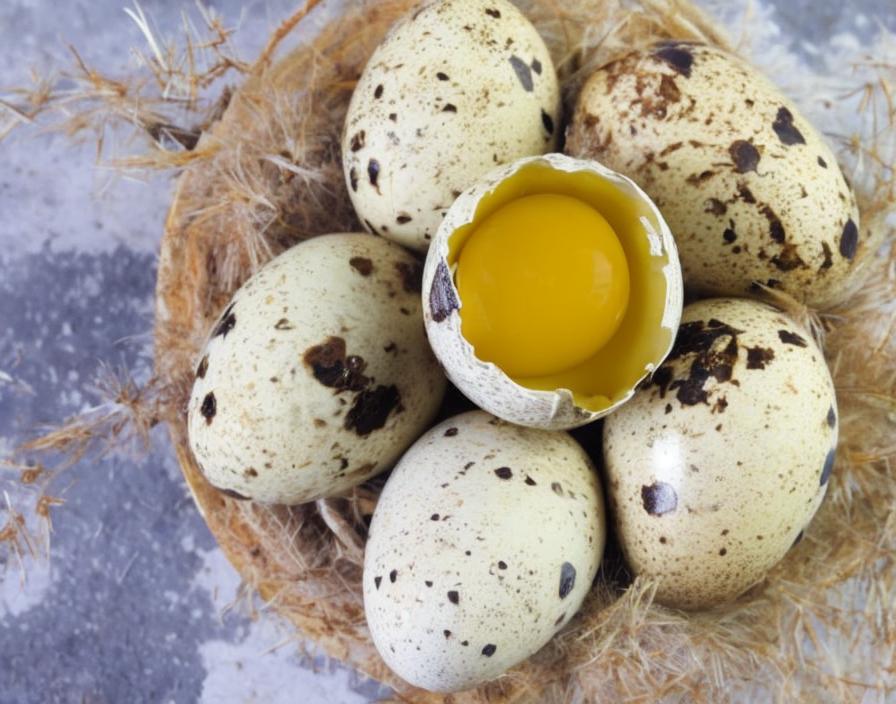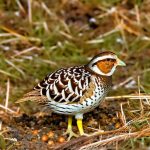Quail are small, ground-dwelling birds that have been domesticated for their eggs, meat, and even as pets. They are known for their prolific egg-laying abilities, making them a popular choice for small-scale egg production. There are several different breeds of quail that are specifically bred for egg production, each with its own unique characteristics and advantages. In this article, we will explore some of the most popular quail breeds for egg production, including the Coturnix quail, Bobwhite quail, California Valley quail, Gambel’s quail, and Button quail. Each breed has its own distinct qualities that make it well-suited for egg production, and understanding the differences between them can help you choose the best breed for your specific needs.
Key Takeaways
- Coturnix quail are the top choice for egg production due to their high egg-laying capacity and fast maturity.
- Bobwhite quail are a popular breed for egg laying, known for their hardiness and adaptability to various climates.
- California Valley quail are colorful and prolific egg layers, making them a visually appealing and productive choice for egg production.
- Gambel’s quail are a unique breed for egg production, known for their distinctive appearance and ability to thrive in arid environments.
- Button quail may be small, but they are mighty egg producers, making them a great choice for those with limited space.
Coturnix Quail: The Top Choice for Egg Production
Coturnix quail, also known as Japanese quail, are perhaps the most popular breed for egg production. They are known for their high egg production rates, with each bird capable of laying up to 300 eggs per year. Coturnix quail are also relatively small in size, making them easy to care for and manage in a small space. They come in a variety of colors, including brown, white, and speckled, and are known for their docile and friendly temperament. In addition to their prolific egg-laying abilities, Coturnix quail are also prized for their delicious and nutritious eggs, which are slightly larger than those of other quail breeds. Their eggs are often used in gourmet cooking and are highly sought after by chefs and food enthusiasts. Overall, Coturnix quail are an excellent choice for anyone looking to start a small-scale egg production operation.
Coturnix quail are also relatively low-maintenance birds, making them an ideal choice for beginners or those with limited experience in raising poultry. They are hardy and adaptable, able to thrive in a variety of climates and environments. They are also known for their fast growth rate, reaching maturity in just 6-8 weeks, which means that they can start laying eggs at a relatively young age. This makes them a cost-effective option for egg production, as they require less time and resources to reach peak productivity compared to other breeds. Additionally, Coturnix quail are known for their efficient feed conversion, meaning that they can produce a large number of eggs while consuming relatively small amounts of feed. This makes them an economical choice for egg production, as feed costs can be a significant expense for poultry operations. Overall, Coturnix quail are an excellent choice for anyone looking to start a small-scale egg production operation.
Bobwhite Quail: A Popular Breed for Egg Laying
Bobwhite quail are another popular breed for egg production, known for their hardiness and adaptability. They are native to North America and are commonly found in the wild, but they have also been domesticated for egg production. Bobwhite quail are slightly larger than Coturnix quail and are known for their distinctive call, which is often heard in the early morning and late evening. They come in several different color variations, including white, brown, and speckled, and are prized for their flavorful eggs. While they may not lay as many eggs as Coturnix quail, Bobwhite quail are still prolific layers, capable of producing up to 200 eggs per year. Their eggs are slightly smaller than those of Coturnix quail but are equally delicious and nutritious.
In addition to their egg-laying abilities, Bobwhite quail are also popular game birds and are often raised for hunting purposes. This dual-purpose nature makes them an attractive option for those looking to raise quail for both eggs and meat. Bobwhite quail are relatively easy to care for and can thrive in a variety of environments, making them a versatile choice for small-scale egg production operations. They are also known for their strong maternal instincts, making them excellent brooders and mothers. Overall, Bobwhite quail are a popular choice for anyone looking to raise quail for egg production or as game birds.
California Valley Quail: A Colorful and Prolific Egg Layer
The California Valley quail, also known as the California quail or Valley quail, is a colorful and attractive breed that is popular for both its ornamental value and its prolific egg-laying abilities. They are native to the western United States and are known for their distinctive plume on their heads and their striking black and white markings. California Valley quail are slightly larger than Coturnix quail and Bobwhite quail and are known for their friendly and sociable nature. They are often kept as pets or ornamental birds in addition to being raised for egg production.
California Valley quail are prolific layers, capable of producing up to 150 eggs per year. Their eggs are slightly larger than those of Bobwhite quail but smaller than those of Coturnix quail. They have a rich flavor and are prized by those who appreciate gourmet eggs. In addition to their egg-laying abilities, California Valley quail are known for their adaptability and hardiness, able to thrive in a variety of climates and environments. They are relatively low-maintenance birds and can be easily cared for by beginners or those with limited experience in raising poultry. Overall, California Valley quail are an excellent choice for anyone looking to raise quail for both ornamental purposes and egg production.
Gambel’s Quail: A Unique Breed for Egg Production
Gambel’s quail are a unique breed that is native to the southwestern United States and northern Mexico. They are known for their striking appearance, with distinctive black and white markings on their faces and chestnut-colored bodies. Gambel’s quail are slightly larger than California Valley quail but smaller than Bobwhite quail and Coturnix quail. They are popular game birds and are often raised for hunting purposes in addition to being kept for egg production.
Gambel’s quail are prolific layers, capable of producing up to 150 eggs per year. Their eggs are similar in size to those of California Valley quail and have a rich flavor that is prized by those who appreciate gourmet eggs. In addition to their egg-laying abilities, Gambel’s quail are known for their adaptability and hardiness, able to thrive in the arid desert environments where they are native. They are relatively low-maintenance birds and can be easily cared for by beginners or those with limited experience in raising poultry. Overall, Gambel’s quail are an excellent choice for anyone looking to raise quail for both egg production and hunting purposes.
Button Quail: A Small but Mighty Egg Producer

Button quail, also known as Chinese painted quail or King quail, are the smallest breed of domesticated quail and are known for their diminutive size and colorful plumage. They come in a variety of color variations, including white, brown, silver, and cinnamon, and are popular as ornamental birds as well as for their egg-laying abilities. Button quail are prolific layers, capable of producing up to 200 eggs per year despite their small size. Their eggs are tiny but pack a flavorful punch that is prized by those who appreciate gourmet eggs.
In addition to their egg-laying abilities, Button quail are known for their sociable nature and can be kept in small flocks without issue. They are relatively low-maintenance birds and can be easily cared for by beginners or those with limited experience in raising poultry. Button quail are also popular as pets due to their small size and colorful plumage, making them an attractive option for those looking to raise quail for both ornamental purposes and egg production. Overall, Button quail are an excellent choice for anyone looking to raise small but mighty birds that can produce a surprising number of delicious eggs.
Choosing the Best Quail Breed for Egg Production
In conclusion, there are several different breeds of quail that are well-suited for egg production, each with its own unique characteristics and advantages. The Coturnix quail is perhaps the most popular choice due to its high egg production rates, efficient feed conversion, and docile temperament. Bobwhite quail are also a popular option due to their hardiness, adaptability, and dual-purpose nature as game birds. California Valley quail are prized for their ornamental value as well as their prolific egg-laying abilities. Gambel’s quail are unique birds that excel in both egg production and hunting purposes. Button quail may be small in size but they pack a punch when it comes to egg production.
When choosing the best quail breed for egg production, it’s important to consider your specific needs and preferences. Whether you’re looking for high egg production rates, dual-purpose birds, ornamental value, or small size with surprising productivity, there is a breed of quail that is perfect for you. By understanding the unique characteristics of each breed, you can make an informed decision that will set you up for success in your small-scale egg production operation. Whether you’re a beginner or an experienced poultry enthusiast, raising quail for eggs can be a rewarding endeavor that provides you with delicious and nutritious eggs while adding beauty and diversity to your flock.
If you’re interested in raising chickens for their eggs, you’ll want to make sure you have the best quail breeds for egg production. Choosing the right breed can make a significant difference in the quantity and quality of eggs you’ll get. To complement your knowledge on this topic, you might find the article “How to Build a Garden Chicken Coop” on PoultryWizard.com helpful. This article provides valuable insights into creating a comfortable and functional living space for your chickens, which is essential for maximizing egg production.
FAQs
What are the best quail breeds for egg production?
The best quail breeds for egg production include the Coturnix quail, also known as the Japanese quail, and the Bobwhite quail. These breeds are known for their high egg production and are popular choices for backyard quail farming.
What makes Coturnix quail a good choice for egg production?
Coturnix quail are known for their high egg production, with some hens laying up to 300 eggs per year. They are also relatively easy to care for and can adapt well to various climates, making them a popular choice for backyard quail farming.
What are the characteristics of Bobwhite quail for egg production?
Bobwhite quail are also good egg producers, with hens laying around 200 eggs per year. They are known for their hardiness and ability to thrive in a variety of environments, making them a popular choice for both commercial and backyard quail farming.
Are there other quail breeds that are good for egg production?
While Coturnix and Bobwhite quail are the most popular choices for egg production, other quail breeds such as the California quail and Gambel’s quail can also be raised for their eggs, although they may not be as prolific as the Coturnix and Bobwhite breeds.
What factors should be considered when choosing quail breeds for egg production?
When choosing quail breeds for egg production, factors to consider include the climate and environment in which the quail will be raised, the availability of resources such as feed and water, and the specific goals and preferences of the quail farmer. It’s important to research and select breeds that are well-suited to the specific conditions and needs of the farm or backyard setup.
Meet Walter, the feathered-friend fanatic of Florida! Nestled in the sunshine state, Walter struts through life with his feathered companions, clucking his way to happiness. With a coop that’s fancier than a five-star hotel, he’s the Don Juan of the chicken world. When he’s not teaching his hens to do the cha-cha, you’ll find him in a heated debate with his prized rooster, Sir Clucks-a-Lot. Walter’s poultry passion is no yolk; he’s the sunny-side-up guy you never knew you needed in your flock of friends!







